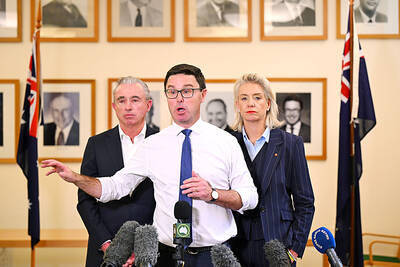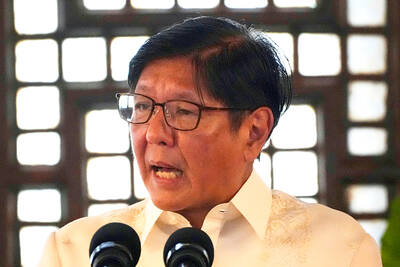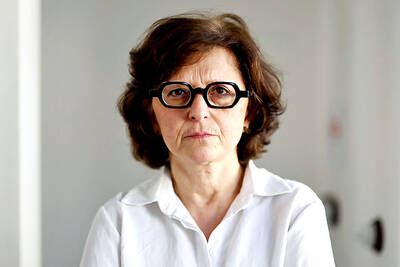Sixty years ago Maurice Kriegel-Valrimont was moving from safe-house to safe-house in German-occupied Paris, masterminding the popular insurrection that was to go down in national legend as the moment France won back its lost military honor.
On Aug. 25, 1944, he was there in the billiards-room of the Prefecture de Police when the capital's military governor Dietrich von Choltitz signed the surrender document, and he was on the half-track which then carried the humiliated general on a triumphant procession through the newly-liberated city.
A famous photograph shows the vehicle moving through ecstatic crowds on the its way to Montparnasse station. General Philippe Leclerc, commander of the French armored division that had just entered Paris, has his back to a bowed and dejected von Choltitz.
Bespectacled and in civilian clothes, Kriegel-Valrimont stands to the rear: the hidden theoretician of revolt who has finally thrown off the cloak of clandestinity to assume his place in history.
Now aged 90 and living in rural Burgundy, he is the last surviving player from one of the key moments of World War II: his mission still today, as a faithful man of the left, to emphasize the role of the anonymous masses in ending four years of Nazi occupation.
"In Paris we had a great advantage -- which was a tradition of popular uprising. There was the revolution of course in 1789, but after that 1830, 1848, above all the Commune in 1870. There was a body of doctrine. We knew how to do it," he recalled in an interview.
"On top of that we had all studied military theory -- Clausewitz and others -- and had a good grasp of when to act: not too early and not too late. I myself had no military training, but I had become an expert," he said.
By mid-August 1944, the writing was on the wall for the army that had marched victoriously into the French capital four years earlier. After the Normandy landings in June, the Allies were sweeping in from the west, and German troops were being withdrawn from Paris to put up a defense elsewhere.
As one of three members of the Military Action Committee (COMAC) of the National Resistance Council (CNR), Kriegel-Valrimont organized a series of strikes. He wrote the inflammatory texts that appeared overnight on fly-posters and underground news-sheets. Then Free French radio began broadcasting, and on Aug. 22 the barricades appeared.
"In 36 hours there were 600 or more. The people were like ants -- tens of thousands of them. Some of the barricades were real masterpieces, built by craftsmen and strong enough to stop a tank. Others would have just collapsed, but the Germans didn't know which was which."
"First fear had changed sides, and now the initiative changed sides too. The Germans were the ones forced onto the defensive, and they fell back on just a dozen centers of operation," he said.
Hundreds of Frenchmen died in the fighting, and their names can still be seen on memorial plaques across the capital which are decorated with flowers every anniversary. But the German collapse was swift, and after three days von Choltitz had negotiated his surrender and was brought to the Prefecture from his headquarters in the Hotel Meurice.
It was here that Kriegel-Valrimont performed the act for which he is most widely known. After seeing that in the original text the Germans surrendered only to Leclerc's army, he insisted that the Resistance -- the French Forces of the Interior (FFI) -- also be included. The wording was changed, with important implications for the balance of power in postwar France.
"To say that it was unforgettable is meaningless. It was phenomenal. No one said a thing, least of all von Choltitz. But when we got to Montparnasse, I and Rol looked at each other. We didn't speak a word, but we both knew what the other was thinking: yes -- it was worth it all for this!" he recalled.
Born into a Jewish family in Strasbourg in 1914, Kriegel -- as he was then known -- enrolled in the Resistance in 1942, and was military planner for the left-wing organisation Liberation in Lyon till his capture and interrogation by the notorious Klaus Barbie. He escaped and made his way to Paris.
After the war he formally adopted the Valrimont which had been his code-name in the Resistance, and became a Communist member of the National Assembly, where he helped introduce statutory pensions -- an achievement he ranks more highly than his role in 1944.
But today his pride is unalloyed.
"Sixty years on whenever a group wants to carry out some act of liberation, they say: `Let's do it like they did in Paris!' We've become the reference, and that can't be bad!"

BACKLASH: The National Party quit its decades-long partnership with the Liberal Party after their election loss to center-left Labor, which won a historic third term Australia’s National Party has split from its conservative coalition partner of more than 60 years, the Liberal Party, citing policy differences over renewable energy and after a resounding loss at a national election this month. “Its time to have a break,” Nationals leader David Littleproud told reporters yesterday. The split shows the pressure on Australia’s conservative parties after Prime Minister Anthony Albanese’s center-left Labor party won a historic second term in the May 3 election, powered by a voter backlash against US President Donald Trump’s policies. Under the long-standing partnership in state and federal politics, the Liberal and National coalition had shared power

CONTROVERSY: During the performance of Israel’s entrant Yuval Raphael’s song ‘New Day Will Rise,’ loud whistles were heard and two people tried to get on stage Austria’s JJ yesterday won the Eurovision Song Contest, with his operatic song Wasted Love triumphing at the world’s biggest live music television event. After votes from national juries around Europe and viewers from across the continent and beyond, JJ gave Austria its first victory since bearded drag performer Conchita Wurst’s 2014 triumph. After the nail-biting drama as the votes were revealed running into yesterday morning, Austria finished with 436 points, ahead of Israel — whose participation drew protests — on 357 and Estonia on 356. “Thank you to you, Europe, for making my dreams come true,” 24-year-old countertenor JJ, whose

NO EXCUSES: Marcos said his administration was acting on voters’ demands, but an academic said the move was emotionally motivated after a poor midterm showing Philippine President Ferdinand Marcos Jr yesterday sought the resignation of all his Cabinet secretaries, in a move seen as an attempt to reset the political agenda and assert his authority over the second half of his single six-year term. The order came after the president’s allies failed to win a majority of Senate seats contested in the 12 polls on Monday last week, leaving Marcos facing a divided political and legislative landscape that could thwart his attempts to have an ally succeed him in 2028. “He’s talking to the people, trying to salvage whatever political capital he has left. I think it’s

A documentary whose main subject, 25-year-old photojournalist Fatima Hassouna, was killed in an Israeli airstrike in Gaza weeks before it premiered at Cannes stunned viewers into silence at the festival on Thursday. As the cinema lights came back on, filmmaker Sepideh Farsi held up an image of the young Palestinian woman killed with younger siblings on April 16, and encouraged the audience to stand up and clap to pay tribute. “To kill a child, to kill a photographer is unacceptable,” Farsi said. “There are still children to save. It must be done fast,” the exiled Iranian filmmaker added. With Israel